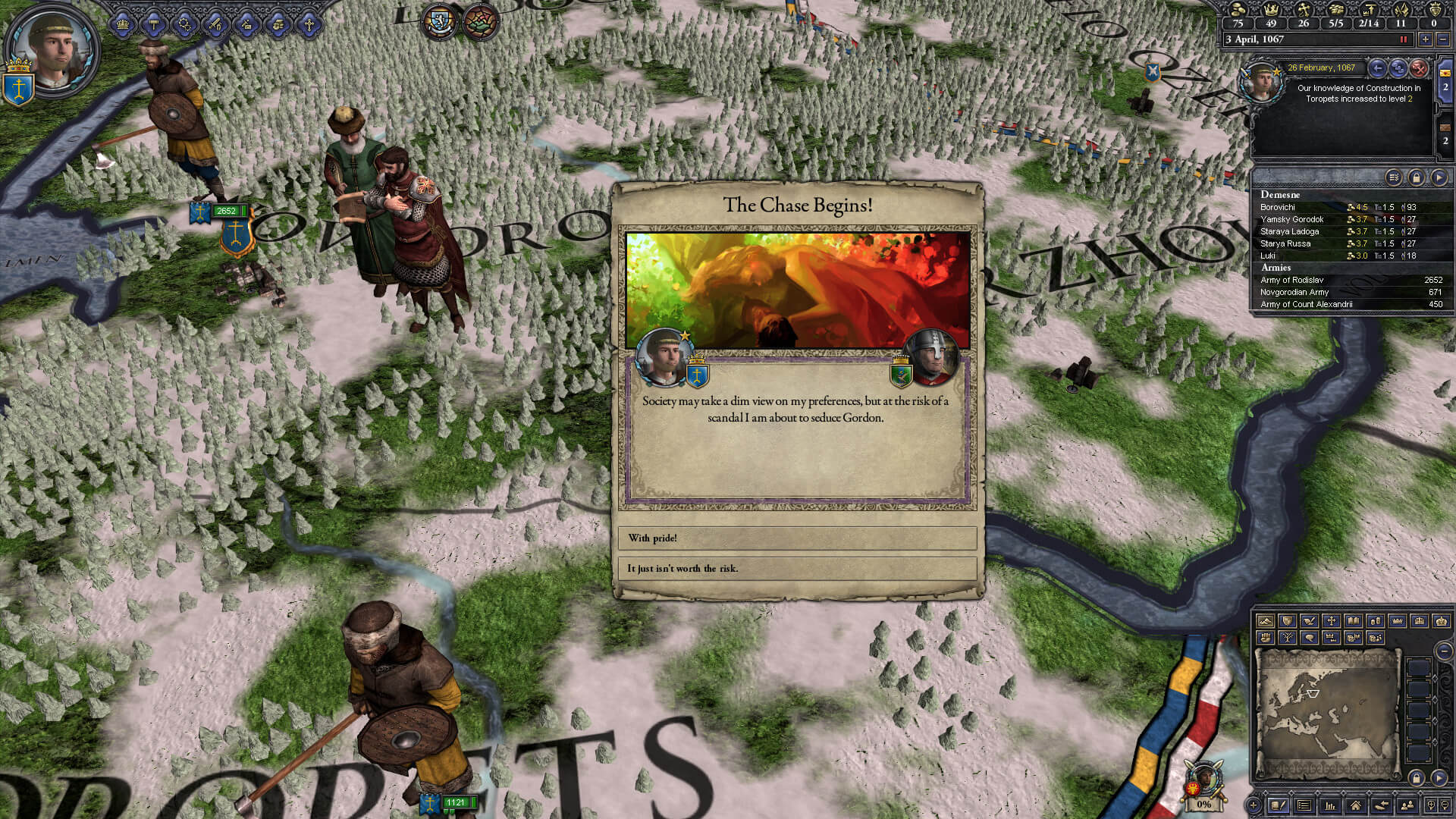
A close but bloody battle, even if you emerge victorious, could end with all of your adult children, your most trusted counselor, and your best friend dead or maimed. A lover serving in your personal guard might sacrifice themselves to save you from a stray arrow. What’s more, the risks of bloodshed now include consequences that can be more shattering to a ruler than losing an entire army. The addition of Knights gives individual, named warriors a bigger role to play in turning the tide, and more opportunities for personal stories to emerge from the din of clashing steel. While combat is still fairly simple and hands-off, from a tactical perspective, the ways it can have repercussions after the fact have been greatly broadened and deepened beyond simple success or failure. Warfare has some strong new ideas too, well beyond the advantage bar that clearly shows you who’s winning a battle at any given moment (a huge improvement over Crusader Kings 2’s arcane and inaccessible number-crunching). Most of the same results were achievable in Crusader Kings 2, but the way you get there is so much richer and more hands-on now. It feels rewarding and viable to work solely in the shadows, building your base of power through trading favors, manipulating the careless, and assassinating those too inconvenient to your schemes. A new system of secrets and hooks allows you to gain leverage over other characters by, for instance, discovering and threatening to expose an extramarital affair. Medieval dynastic politics would be nothing without a little cloak and dagger, and this is another area where Crusader Kings 3 has gone all out. The possibilities are practically limitless, and allow you to customize your experience and leave your mark on the world in very satisfying ways that were never possible in the previous games. Everything is customizable, from the role of the clergy to views on witchcraft and homosexuality. You can create a new heresy of Catholicism that, for instance, exalts cannibalism, believes in reincarnation, and allows only women to become priests. Of course, due to the in-depth, free-form new religion system, you can always bid farewell to a religious doctrine that no longer suits you.
#CRUSADER KINGS 3SIZE FULL#
Read the full Crusader Kings 3: Royal Court DLC Review It's the best kind of grand strategy expansion, and while it leaves dukes and tribal rulers feeling a bit left out in the rain as they can't access most of these new systems, I wouldn't want to ever play without it. And rather than focus on one region, all the pillars and ethoses added by the new culture system make it feel like a flavor pack for the entire world. It weaves iron into the very fibers of the base game and makes it feel more complete and cohesive. Not shown in character's title.Whether I'm creating new melting pot cultures, decorating my throne room, or throwing lavish parties to make sure everyone remembers how important I am, Royal Court goes beyond tacking on some new mechanics to the already excellent Crusader Kings 3. The mother of a King-tier or Emperor-tier ruler.Ĭhildren of a King-tier or Emperor-tier ruler.Ĭoncubinage marriage mechanic. Realm heir, in case of Tanistry succession law. Uses the other gender version of the ruler's title. Unlike honorary titles, these titles are granted automatically and cannot be revoked: Some minor titles are linked to the realm and the relatives of the ruler.

With, realm size is part of the conditions for creating custom kingdoms and empires.

The "Realm Tree" view also shows realm sizes for all rulers in an independent realm. You can see the realm size of other rulers by hovering their demesne size box (above their wealth, prestige, and piety). Your realm size is shown at the top right corner of the screen. However, buildings can change this power-balance a lot.

It is useful for estimating a character's approximate power the larger the realm, the more powerful they generally are. Realm size is the total number of settlements (castles, cities, temples, and tribes) in a realm. A Duke within a Kingdom, for example, is the ruler of a sub-realm consisting of his Duchy and all his vassals.


 0 kommentar(er)
0 kommentar(er)
